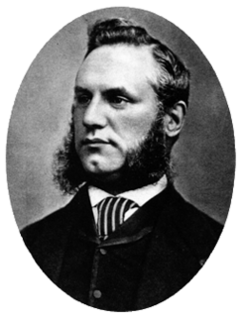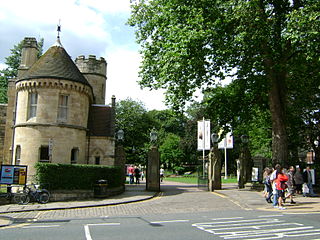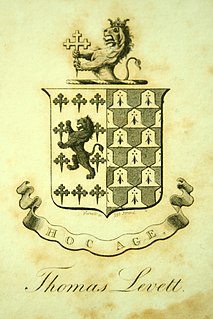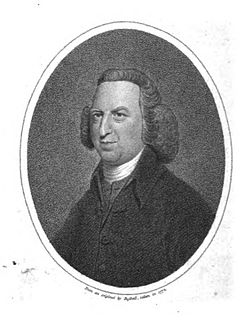
An antiquarian or antiquary is an aficionado or student of antiquities or things of the past. More specifically, the term is used for those who study history with particular attention to ancient artifacts, archaeological and historic sites, or historic archives and manuscripts. The essence of antiquarianism is a focus on the empirical evidence of the past, and is perhaps best encapsulated in the motto adopted by the 18th-century antiquary Sir Richard Colt Hoare, "We speak from facts, not theory."

Sir William Matthew Flinders Petrie, FRS, FBA, commonly known as Flinders Petrie, was an English Egyptologist and a pioneer of systematic methodology in archaeology and preservation of artefacts. He held the first chair of Egyptology in the United Kingdom, and excavated many of the most important archaeological sites in Egypt in conjunction with his wife, Hilda Petrie. Some consider his most famous discovery to be that of the Merneptah Stele, an opinion with which Petrie himself concurred.

Henry Hobson Richardson was a prominent American architect, best known for his work in a style that became known as Richardsonian Romanesque. Along with Louis Sullivan and Frank Lloyd Wright, Richardson is one of "the recognized trinity of American architecture".

The Abbey of St Mary is a ruined Benedictine abbey in York, England and a Grade I listed building.

William Robertson FRSE FSA Scot was a Scottish historian, minister in the Church of Scotland, and Principal of the University of Edinburgh. "The thirty years during which [he] presided over the University perhaps represent the highest point in its history." He made significant contributions to the writing of Scottish history and the history of Spain and Spanish America.

Joseph Hunter was a Unitarian Minister, antiquarian, and deputy keeper of public records now best known for his publications Hallamshire. The History and Topography of the Parish of Sheffield in the County of York, the two-volume South Yorkshire , still considered among the best works written on the history of Sheffield and South Yorkshire, and his 1852 pamphlet on Robin Hood in which he argued that a servant of this name at the court of Edward II was identical with the famous outlaw. His name was adopted by the Hunter Archaeological Society.

John Smith was an English brewer. He is best known for operating the John Smith's Brewery in Tadcaster, North Yorkshire, which continues to operate.

The York Museum Gardens are botanic gardens in the centre of York, England, beside the River Ouse. They cover an area of 10 acres (4.0 ha) of the former grounds of St Mary's Abbey, and were created in the 1830s by the Yorkshire Philosophical Society along with the Yorkshire Museum which they contain.

Very Rev. William Carrigan was an Irish Roman Catholic priest and historian, who was appointed canon of the Diocese of Ossory.

Walter Henry Brierley (1862–1926) was a York architect who practised in the city for 40 years. He is known as "the Yorkshire Lutyens" or the "Lutyens of the North". He is also credited with being a leading exponent of the "Wrenaissance" style - incorporating elements of Christopher Wren.

The Yorkshire Philosophical Society (YPS) is a charitable learned society which aims to promote the public understanding of the natural sciences, the social sciences, and the archaeology and history of York and Yorkshire.

Levett is a surname of Anglo-Norman origin, deriving from that of the French de Livet, which is held particularly by families and individuals resident in England and British Commonwealth territories.
Frederic Hardwicke Knight, QSO was a London-born photographer, historian and collector who emigrated to New Zealand in 1957 to take up a medical photography position in Dunedin. He lived at Broad Bay until ten months before his death at a Dunedin nursing home. His publications include New Zealand's first comprehensive photographic history, many compilations of early Dunedin and Otago photographs, biographies of several early New Zealand photographers and of British photographer William Russell Sedgfield, three books of architectural history and a seminal history of the Otago Peninsula. He was awarded a QSO in 1991. An eccentric polymath, Knight was well known for his striking appearance, his ramshackle Broad Bay cottage crammed with his collections and his self-proclaimed exploits, most notably his claim to have found timbers on Mount Ararat that might have been Noah's Ark.

The Cambrian Archaeological Association was founded in 1846 to examine, preserve and illustrate the ancient monuments and remains of the history, language, manners, customs, arts and industries of Wales and the Welsh Marches and to educate the public in such matters. The association's activities include sponsoring lectures, field visits, and study tours; as well as publishing its journal, Archaeologia Cambrensis, and monographs. It also provides grants to support research and publications.
John West Hugall was a British Gothic Revival architect from Yorkshire.
William Arthur Evelyn was a distinguished historian of York, and the creator of the Evelyn collection.

Leslie Peter Wenham MA, M.Litt, M.Ed, FSA was a British archaeologist, historian, and professor who excavated in York, on Hadrian's Wall and Malton. He was the first to produce a comprehensive report of a Romano-British Cemetery. He is known for his extensive publications in archaeology. He was elected a Fellow of the Society of Antiquaries of London in 1970. Wenham had also served with the Royal Army Ordnance Corps during the Second World War.

Richard Conyers (1725–1786) was an English evangelical cleric, and the hymn-book compiler of a precursor to the Olney Hymns. He became well known as the parish priest of Helmsley in the North Yorkshire Moors, a cure of scattered villages.

William Mark Ormrod, was a Welsh historian who specialised in the Later Middle Ages of England. Born in South Wales, he studied at London University and then earned his Doctor of Philosophy at Oxford. He was employed at a number of institutions, eventually settling at the University of York where he became Dean of the History Faculty and director of the Centre for Medieval Studies. He researched and published widely, including nine books and over 80 book chapters. Ormrod retired in 2017 and died of cancer in 2020.
Terence Frederick Friedman (1940-2013) was an American-born art and architectural historian and museum curator. After his death in Leeds, UK, The Sculpture Journal, in their tribute, defined him as ‘a rare being - a scholar curator working in a regional museum, and an outstanding art historian, educator and collector’. He was also a highly acclaimed author and respected as a leading authority on 18th century ecclesiastical architecture. His book, The Eighteenth-Century Church in Britain, the first substantial study of the subject to appear in over half a century, won the William MB Berger Prize for British Art History in 2012.















